ADINFER-ChessEVAL ©
Dedicated Chess Computers
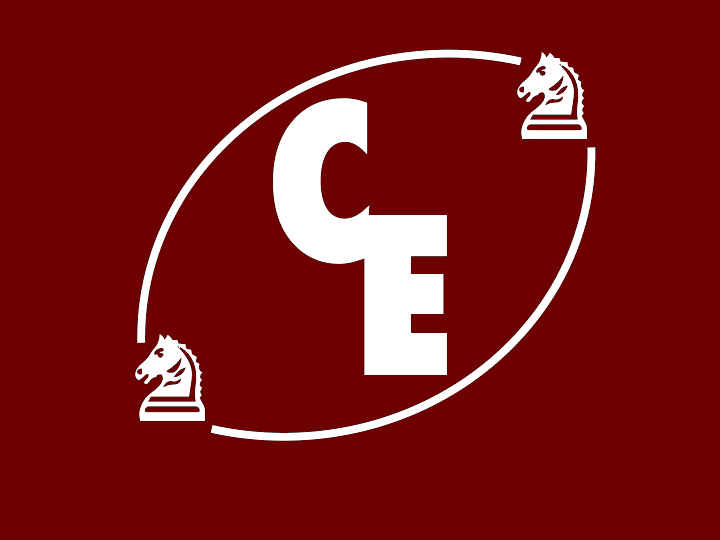
| CYBERCHESS Advertisement |
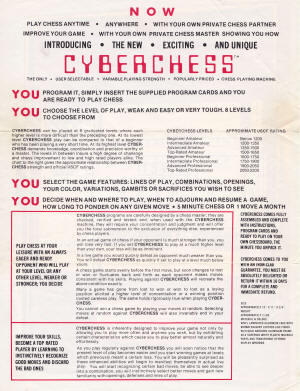 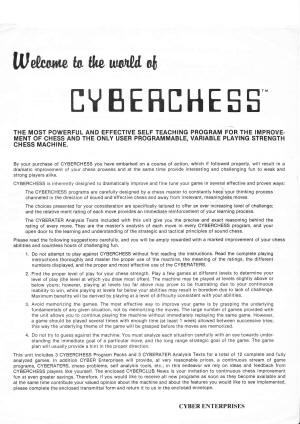 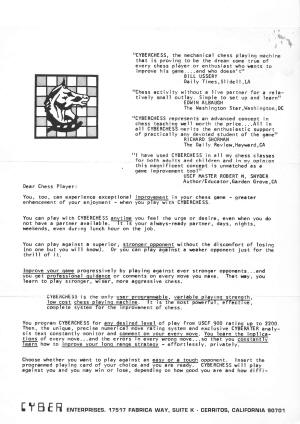 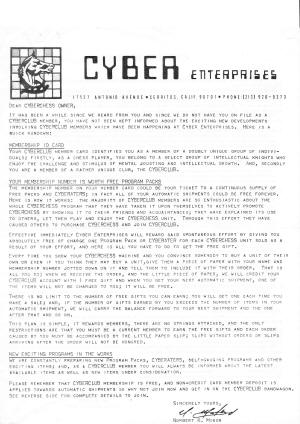   Many thanks to Wayne Revox, Canada |
| CYBERCHESS from Cyber Enterprises - Pamphlet and instruction manual - |
|
CHESS AND THE
COMPUTER Since the advent of computer man has attempted, with varied degrees of success, to program electronic devices to play chess. Today's modern computers with their lightning calculating speeds and their vast solid state memories indeed do play chess.
Tournaments in which
computers play computers are being held, and the
best computer programs using the biggest and most
powerful machines, are being pitted against each
other. However, even with the advances of modern
technology, contests between chess players and
machines have proven man to be vastly superior.
The human brain possesses two miraculous attributes which set it apart from any machine, intuition and originality or creativity; no computing device no matter how sophisticated can boast of these capabilities. The number of possible
moves and counter moves in an average game of chess
staggers the imagination. In an attempt to define
this number the term googol has been created where a
googol is a 1 followed by 100 zeros. When a chess player ponders over a chessboard position, trying to decide on his next logical move, he does not consider each one of the googols of possible moves, countermoves and answers, he does not analyze exhaustively all possible chains of combinations as such task is beyond any man or machine. The chess player draws on
his recollection of proven principles of sound play
and uses his intuition and creativity to intuitively
discard all irrelevant and meaningless choices,
concentrating his attention on only a handful of
relevant and plausible moves, and from among these
he selects his next play. This instantaneous and
intuitive narrowing down is not possible without
intuition and creativity.
When a computer analyzes a chess position stored within its electronic memory, it is confronted with the same googols of possibles, and not having the ability of arriving at creative and intuitive solutions it must reach its decision by using the principles of sound play programmed into it, and comparing each and every possible move, countermove, and answer against those principles and against each other. This task is so
staggering that even the fastest and most powerful
machine would require a memory larger than a city
and it would take years to complete a game. Thus a perfect chess
playing machine is technologically not feasible at
this time; and although a machine capable of holding
its own with the best humans is theoretically
possible, it is highly impractical due to the space,
energy and millions of dollars it would require to
build.
Spurred on by the desire
to create a small and portable chess
playing machine within the economic reach of
the average chess player, It was necessary to
compromise the quality of the game by limiting
the size of the electronic memories and the
allowable time to analyze the game; thus
randomly discarding the vast majority of move
choices.
The fruits of these efforts have been a few small electronic chess playing machines which dot the market, and more undoubtedly will be designed and produced. All such devices however
suffer from common shortcomings; they are
expensive, in the $100 to $200 price range; they
either take an inordinate amount of time for
each move or they are only capable of a
ludicrously low level of play denying any
challenge to all but the most inexperienced
beginner. The few computers capable
of fairly decent play are large machines
which utilize sophisticated mass storage devices
and whose $100,000 plus price tag places them
outside the affordability range of the average chess
player.
THE CYBERCHESS
PRINCIPLE In order to create a
chess playing machine which is small, simple enough
to make it affordable and yet capable of playing
superb chess; it was necessary to adopt the
computer's ability of following a preprogrammed path
and at the same time preserve the human brain's
ability of intuitive and creative reasoning. Certain compromises were
necessary, but they were made where they detract the
least from the game's integrity.
By limiting the computing
time and memory size of an electronic machine the
number of choices presented to the computer and
requiring its analysis has not diminished, only its
ability to reply has deteriorated.
CYBERCHESS
limits the actual number of moves
presented to it by you the player thus limiting the
number of required answers. The moves discarded by a
computer when it runs out of time and memory space,
are discarded randomly, without consideration to
their soundness and plausibility. The moves discarded from
your consideration by CYBERCHESS are
discarded by a human brain, the brain of a highly
rates chess master, who has used his talent,
intuition and creativity to preselect the most
meaningful and plausible moves, for your level of
play; and it is from among these moves that you make
your next choice. Just as in a live game, the
majority of the discarded moves would have been
intuitively discarded by you anyway. The compromise of not
allowing you the whole range of all possible moves
and variations is more than amply compensated by
skillful chess analysis coupled with a method of
presentation which faithfully preserves the
challenge, thrill, penalty/reward characteristics
and playing ability requirements of a chess game.
CYBERCHESS
programs are carefully designed by a chess
master; they are checked, verified and tested; and,
when used with the CYBERCHESS machine,
they will require your concentration and judgment
and will offer you the total submersion to the
exclusion of everything else, experienced by chess
players. In an actual game of
chess if your opponent is much stronger than you,
you will lose very fast. If you set
CYBERCHESS to play at a much higher
level than your own, your loss will be as imminent. In a live game you would
quickly defeat an opponent much weaker than you. You
will defeat CYBERCHESS as
quickly if set to play at a level much below yours. A chess game starts
evenly before the first move, but soon changes to
lost or won or fluctuates back and forth as each
opponent makes moves consistent with his skills.
Playing against CYBERCHESS will
recreate the above condition exactly. Many a game has gone from
lost to won or won to lost as a losing position
elicited a higher level of concentration or a
winning position invited careless play. The same
holds rigorously true when playing CYBER-CHESS. In a game against a live
opponent you only win if you do not make any major
blunders, play better than he and checkmate him
before he mates you. Again the same holds true with
CYBERCHESS . You cannot win a chess
game by playing your moves at random. Selecting
moves at random against CYBERCHESS will
also invariably end in your defeat.
CYBERCHESS AND
YOUR RATING CYBERCHESS can be played at 8 levels and each higher level is more difficult than the preceding one. At its lowest level CYBERCHESS play can be compared to that of a beginner who knows the moves but does not formulate plans and who has been playing a very short time. At its highest level
CYBERCHESS demands knowledge, coordination
and precision worthy of a master. It is impossible to
establish an exact comparison between CYBERCHESS
levels and an established rating like that of
the United States Chess Federation (USCF)
for instance; however, a very approximate parallel
can be drawn and when done so, it becomes very
useful in your initial determination of the level of
play.
The following chart attempts to correlate CYBERCHESS levels to USCF ratings. It is only an
approximation and it may vary not only from level to
level but from game to game within the same level,
as no two chess games or opponents are exactly
alike.
CYBERCHESS
LEVELS
APPROXIMATE USCF EQUIVALENT Beginner Amateur
Below 1200 Intermediate Amateur
1200-1350 Advanced Amateur
1350-1500 Top-Rated Amateur 1500-1650 Beginner Professional
1600-1750 Intermediate Professional 1750-1900 Advanced Professional 1900-2050 Top-Rated Professional
2050-2200 As you play CYBERCHESS,
you will soon find your proper level of play and
the above guide will be unnecessary to locate your
level. IMPROVING YOUR GAME
WITH CYBERCHESS CYBERCHESS
is inherently designed to improve
your game not only by allowing you to play more
often and anytime you wish, but by exhibiting
certain characteristics which cause you to play
better almost naturally and effortlessly. As you play regularly against CYBERCHESS you will soon notice that the present level of play becomes easier and you start winning games at levels which previously meant a certain loss. You will be pleasantly surprised as these enhanced abilities will begin to manifest themselves in actual live play. You will start
recognizing certain bad moves, be able to see deeper
into a combination, you will instinctively select
better moves and gain new familiarity with openings,
defenses and lines of play. This learning is a slow
and almost unnoticeable process, however, it is
there; and the following paragraphs will allow you
to use the machine's inherent teaching features to
the fullest.
CYBERCHESS
teaching process operates through 2
very strong principles: a continuous numerical
indication of what is ahead, acting as a strong
motivator to concentrate and analyze more carefully;
and an instantaneous reinforcement through
punishment/reward, acting as a powerful memory
engraving tool.
As you play a game
against CYBERCHESS , each time you advance,
you expose a positive number in the level window,
which you add on the status dial. This number is an
indication of the difficulties lying ahead in
selecting the right move. The higher this number the
harder it will be to find the correct move, and
consequently you should make an extra effort to find
it, as the penalties you may incur could swing the
status dial deep into the losing side. Each time you select and
verify a move, you expose a reward or penalty which
is an indication of how good or bad the move is: A rating of +1 or 0 means
you have chosen well; the move is very good although
not the right one. A rating of -1 is not
bad, but it is not the best move. You cannot lose a
game by constantly choosing - 1 rated moves. A rating of - 2 or higher
indicates bad moves, and the higher the negative
number the worse the move. These are the losing
moves. A move rated X is a
disastrous move, you will not forget it easily as it
ends the game abruptly. It is not very likely that
you will hit X moves unless you are not
concentrating, playing at random or playing
extremely above your level. CYBERCHESS can help to develop some positive insights into the game. However, it does that through repetitive play through all levels of difficulty and requires a thorough exploration of the reasons for not selecting the bad moves. The approach used in CYBERCHESS keeps the concentration level up and forces you to study the score to a greater degree than you would have in just reviewing the game on your own with the cryptic notation generally supplied as comments by most chess analysts and editors. |
| CYBERCHESS from Cyber Enterprises - Instruction manual |
|
The CYBERCHESS machine can be set to one of four levels: - BEG (Beginner), - INT (Intermediate), - ADV (Advanced), - TOP (Top-Rated), while CYBERCHESS game programs come in 2 classes: PRO (Professional), and AMT (Amateur). Therefore you have the following 8
distinct levels of play at your disposal: 1.
Beginner Amateur 2.
Intermediate Amateur 3.
Advanced Amateur 4.
Top-Rated Amateur 5.
Beginner Professional 6.
Intermediate Professional 7.
Advanced Professional 8.
Top-Rated Professional The standard program pack included with this set contains 4 complete games, 2 professional and 2 amateur. Additional program packs of 4 games each, of either amateur or professional class, can be obtained from CYBER Enterprises. A program index describing all available programs and their features, a handy order form and a pre-addressed envelope are enclosed for your convenience. Each new
program pack contains an updated index as new programs
are being added continuously.
Part I of this manual is devoted to acquainting you with CYBERCHESS and its use. It is very important that you read the
following instructions prior to attempting to play, as a
good understanding of the procedures will result in many
hours of error free chess. In Part II, the idea behind
CYBERCHESS is explored; its strengths and weaknesses
are analyzed, and the principles used to improve your
game and compare your strength to that of CYBERCHESS are
explained. THE MACHINE AND ITS PARTS The CYBERCHESS machine and
Its parts are shown on the opposite page. This section will
familiarize you with these parts and their names. You should
locate on your machine each part as you read its
description. CURSOR: The
cursor is the large moving part with the name CURSOR
on its handle. It also has the words LEVEL, SELECT,
VERIFY and other captions printed on its face. You can
move the cursor by grasping the cursor handle with your
fingers and sliding it up and down. Try it. SLIDERS: The
6 narrow stubs protruding from under the cursor's face are
called the sliders. Each slider can move independently to an
up or down position. To move a slider down place your thumb
on the cursor handle and gently push the slider, using your
middle finger, under the upper edge of the cursor face. To move a slider up place your
middle finger on the cursor handle and gently slide the
slider, with your thumb, under the lower edge of the cursor
face. Try moving the sliders up and
down without moving the cursor itself. Note that the sliders are
designed to expose a slit in the cursor when they are either
up or down, but not both slits at once. SELECT WINDOW:
The long and narrow horizontal slit in the cursor,
exposed when a slider is down, is called the select window,
the word SELECT and 6 arrows point upwards to it. VERIFY WINDOW:
The verify window is the long and narrow horizontal
slit in the cursor, exposed when a slider is up. The word
VERIFY and 6 arrows point downward to it. LEVEL WINDOW:
The long and narrow vertical opening on the left side
of the machine and exactly under the word LEVEL is
called the level window. Note that the cursor's face covers
part of the level window and a small arrow points to each
level of play. LEVEL SELECTOR:
The long and narrow rectangular part (inside the level
window) with 1/4 cut out is called the level
selector. The level selector may be inserted in the level
window in any one of 4 positions so that only 1/4 of
the window is open. By exposing the quarter of the level
window pointed at by the little arrow on the cursor face,
one of 4 levels of play: BEG, INT, ADV, or TOP
may be selected. Try it. REGISTER INDEX:
The vertical strip to the right of the cursor, with
the letters F, G, T, X, V, Y, Z, R and A vertically printed
on it, is the register index, and it is used to set the
register. REGISTER & REGISTER WINDOW The register is the smaller moving part
with the word REGISTER on its handle, it also has a
small horizontal window in it called the register window. You can move the register by grasping the register handle with your fingers and sliding it up and down. To position the register at Z simply slide the register until the line on its handle is aligned with the small index mark next to the Z. Try setting the register
at X,Y. etc.
STATUS INDICATOR The status indicator is the round offset on the bottom
right of the machine with a small hole in it and the word
STATUS printed vertically next to the hole. Note that it also has 2 ranges of
numbers, one positive from +1 to + 8 and one negative from
-1 to - 8.
STATUS DIAL:
The status dial is a wheel with index marks on its outer
edge. It is located under the status indicator so that only
its edge is exposed. You can rotate the status dial by
placing your finger against its edge and gently turning it
either clockwise or counterclockwise. Try it. The status wheel is used to add or subtract any number from 1 through 8. To add 4 to the existing status for instance simply place your finger on the status dial next to + 4 and then rotate this line clockwise until it is aligned with the arrow on the status indicator. To subtract a number simply align the line next to the
negative number with the arrow.
PROGRAM CARD SLOT The program card slot is the long narrow slit in the right edge of the machine. It is used to load program cards
into the machine. At this point you should be familiar with ail the machine parts. The following list will
serve as a self check. If you do not recognize or cannot
locate on your machine any of the items listed below, go
back and re-read the section about that item. Cursor
Register Index Sliders
Register Select Window Register Window Verify Window Status Indicator Level Window Status Dial Level Selector Program Card Slot
|
| Learn Chess from the Masters |
|
CYBERCHESS takes some of the winning
games of the greatest chess players and lets you play their
pieces. It uses a multiple choice format in which the Grand Master's move at each stage of play is included as one of six options. Each of the moves has a point value associated with it. When you select the correct move, you are credited with one point. When you select any of the other moves, you may lose as few as O points (if the analyst considers that move equal to the Grand Master's) to as many as six points. Some moves are considered so bad that recovery is impossible, and you lose immediately. There is an instructional mode, in which there is no time limit imposed on your play and some notation is available for each of the wrong alternatives. There are also two modes of tournament-timed play and two variations of speed play available. For learning, the instructional mode is the one to use. CYBERCHESS requires that you use a chessboard and a set of chessmen. To start, the first few moves are given, since they are standard openings. At this point, the board is displayed so that you can check the position of your pieces on your board. After each tenth move, the board is displayed again. You make the moves for one set (designated by CYBERCHESS ) and the opponent's response is given to you immediately. Before you go on to the next move, you may select any of the alternatives for the analysis or comment. Of course, there is value in the analyses provided by CYBERCHESS . Careful study of the position at each move can provide valuable insights into the game, if all levels of difficulty are explored. The benefits to be gained by using CYBERCHESS are realized by studying the moves the Grand Masters do not make and checking the program's analysis of those moves. If you can learn to understand why a given move in a sequence is bad, you will improve your chess by reducing the number of bad moves you make. If you do not know anything at all about chess, CYBERCHESS will be of little or no value to you. It will not teach you how each of the pieces moves or any of the principles of good position play or long range strategy. CYBERCHESS assumes that you already know how to play. At the beginning of each game, it presents a statement that is supposed to help to guide you through the moves. In fact, it tells you something of what happens in the game, but it does not tell you what the early rationale of the master was which determined the line of play he chose. Good chess players generally confine their moves to traditional lines, paying attention to maintaining good position, until they find (or think they find) a weakness in their opponent's position. They then put pressure on the weak spot until a major weakness develops. In CYBERCHESS each move is made and evaluated in terms of short term goals. The objectives of the masters are displayed solely on the basis of results. Once you have learned some of the fundamentals of good play, CYBERCHESS can help to develop some positive insights into the game. However, it does that through repetitive play through all levels of difficulty and requires a thorough exploration of the reasons for not selecting the bad moves. The approach used in CYBERCHESS keeps the concentration level up and forces you to study the score to a greater degree than you would have in just reviewing the game on your own with the cryptic notation generally supplied as comments by most chess analysts and editors. The list of additional game packs to be used with the program (four games to the pack) groups the games according to difficulty (amateur or professional). (Document from Wayne Revox) |
| Computerized Versions of CYBERCHESS |
|
"Cyberchess for Model I (DSK) - Norbert Mikun/Cyber Enterprises
(1982) Cyberchess(r) Program Pack System (c)(p) Cyber Enterprises
1982 - All Rights Reserved". Other versions were made for the Commodore 64, the Apple II, the IBM-PC, XT and other compatibles.
|
|
F |
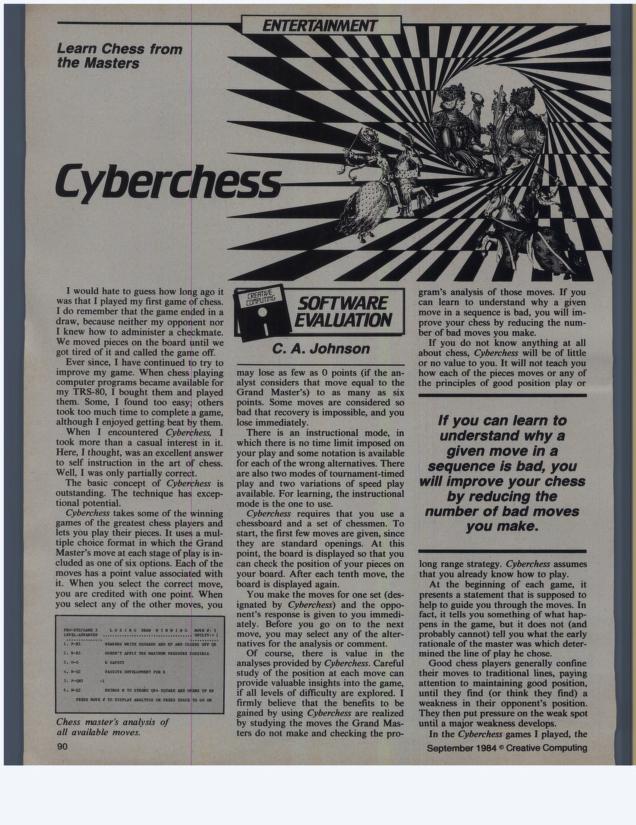  Reference: Johnson CA, Creative Computer Magazine, 1984 |